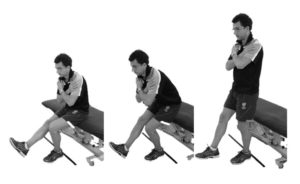Functional or physical performance tests, such as hop tests, are commonly used by physiotherapists and other rehabilitation clinicians to evaluate recovery after anterior cruciate ligament (ACL) injury and reconstruction. Indeed, they make up a vital part of the clinical decision on when to progress patients to next stages of rehabilitation and when an athlete can safely return to sport after ACL injury.
But can they predict the future? Are these functional tests of knee and lower-limb capacity that we use so often in the clinic able to tell us anything about future outcomes? Thankfully the answer is yes. Performance on functional tests performed after ACL injury can provide valuable information on future risk of poor knee symptoms, impaired quality of life, graft rupture and other knee injuries, and long-term osteoarthritis development.
- In 91 people with ACL injury treated non-operatively, a hop for distance limb symmetry index (LSI=injured leg ÷non-injured leg) of <88% at 2.5 months after injury predicted worse self-reported knee function (ie. IKDC score) 1-year later (Grindem et al., 2011).
- In 180 people with ACL reconstruction, a hop for distance LSI of <90% 1-year after surgery predicted the presence of radiographic tibiofemoral osteoarthritis 10-years postoperatively (Pinczewski et al., 2007).
Triple crossover hop for distance
- In 85 people following ACL reconstruction, single legged hop tests (particularly the triple crossover hop and 6-metre timed hop) LSI <88% at 6-months after surgery predicted an unsuccessful outcome, assessed with the IKDC score, 1-year postoperatively (Logerstedt et al., 2012).
- In 93 people following ACL reconstruction, an inability to perform ≥22 one leg rises on the reconstructed knee at 1-year post-surgery predicted poorer knee-related quality of life (ie. KOOS-QOL score) at 3-years postoperatively (Culvenor et al., 2016).
- In 87 people from the KANON trial with ACL injury treated with either rehabilitation alone or ACL reconstruction plus rehabilitation, performance (ie., LSI) on a variation of the one leg rise test (the lowest sitting height from which able to stand up on one leg) at the completion of ~8-months of rehabilitation predicted self-reported knee function at 2- and 5-years post-injury (Ericsson et al., 2013).
6 metre timed hop
- In 145 people with ACL injury, after 2-months of non-operative rehabilitation, performance on the 6-metre timed hop helped to explain those who later underwent ACL reconstruction and those who continued non-operative management (Eitzen et al., 2010).
Battery of hop tests
- As part of return to sport criteria in 109 people following ACL reconstruction, achieving >90% LSI on each test in a battery of functional tests (hops, strength) resulted in only 6% reinjuries over the following 2-years, compared to 38% reinjuries in those with <90% LSI (Grindem et al., 2016).
- Using a similar discharge criteria in 158 male professional athletes, those with >90% LSI on each hop and strength test had a 4-times lower risk of ACL graft rupture compared to those with <90% LSI (Kyritsis et a., 2016).
What to do in the clinic?
Let’s use these clinical tests of functional performance and their prognostic ability to empower and motivate patients along their ACL rehabilitation journey. They provide instant feedback in the clinic and their important impact on future outcomes can be utilised to enhance motivation and adherence to rehabilitation.




